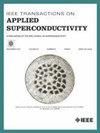确定充电电流波形以减小HTS核磁共振磁体中筛选电流感应场的研究
IF 1.8
3区 物理与天体物理
Q3 ENGINEERING, ELECTRICAL & ELECTRONIC
引用次数: 0
摘要
在本文中,我们提出了一种确定合适的充电电流波形的方法,以减轻核磁共振级高温超导磁体中的屏蔽电流感应场(SCF)。研究发现,筛选电流降低了核磁共振级高温超导磁体的磁场质量,并且这种降低的程度取决于充电电流波形。我们开发了一个模拟程序来预测当将特定的充电电流波形应用于给定的高温超导磁体时屏蔽电流的影响。使用该程序,我们能够确定哪种电流波形最适合给定的高温超导磁体。为了验证程序的性能,我们将相同的电流波形应用于实际的核磁共振级高温超导磁体,并测量了中心磁场。我们将实验结果与模拟结果进行了比较,证实两者几乎相同。这项技术有望使我们在进行耗时且资源密集的充电实验之前,确定最合适的充电电流波形,以减少筛选电流。本文章由计算机程序翻译,如有差异,请以英文原文为准。
A Study on Determining Charging Current Waveform to Reduce Screening Current Induced Field in HTS NMR Magnets
In this paper, we present a method for determining the appropriate charging current waveform to mitigate the screening-current-induced field (SCF) in an NMR class HTS magnet. It has been observed that screening currents degrade the magnetic field quality of NMR class HTS magnets, and the extent of this degradation varies depending on the charging current waveform. We developed a simulation program to predict the effects of screening currents when applying specific charging current waveforms to given HTS magnets. Using the program, we were able to determine which current waveforms are most suitable for a given HTS magnet. To validate the performance of the program, we applied the same current waveforms to the actual NMR class HTS magnet and measured the central magnetic field. We compared the experimental results with the simulations and confirmed that they were nearly identical. This technique is expected to allow us to determine the most suitable charging current waveform for reducing screening currents before conducting time-consuming and resource-intensive charging experiments.
求助全文
通过发布文献求助,成功后即可免费获取论文全文。
去求助
来源期刊

IEEE Transactions on Applied Superconductivity
工程技术-工程:电子与电气
CiteScore
3.50
自引率
33.30%
发文量
650
审稿时长
2.3 months
期刊介绍:
IEEE Transactions on Applied Superconductivity (TAS) contains articles on the applications of superconductivity and other relevant technology. Electronic applications include analog and digital circuits employing thin films and active devices such as Josephson junctions. Large scale applications include magnets for power applications such as motors and generators, for magnetic resonance, for accelerators, and cable applications such as power transmission.
 求助内容:
求助内容: 应助结果提醒方式:
应助结果提醒方式:


